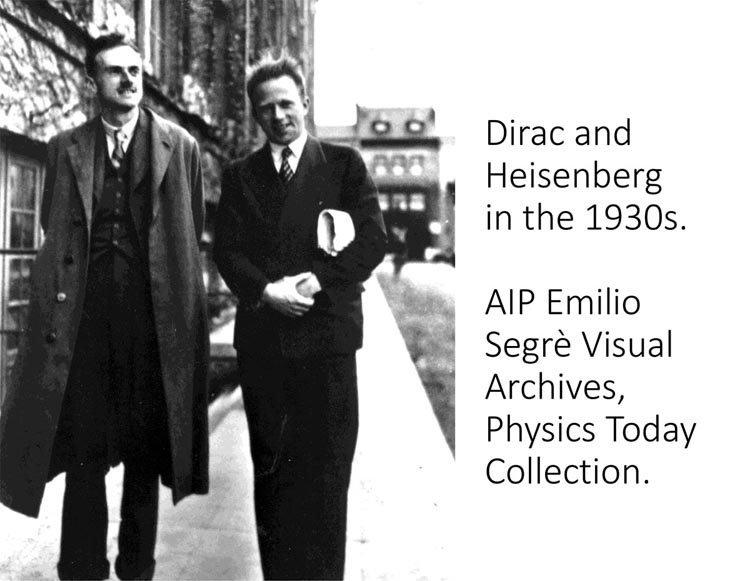E = mc2 from Heisenberg?
Crazy?
E = mc2 from Heisenberg?
Crazy?
- Crazy?
To be called "crazy" is the highest honor for a scientist.
- If the 18th and 19th Centuries were for colonialists, the 20th Century was for
scientists. Among the most prominent scientific theories developed during this
century are
- Einstein's theory of relativity for space and time,
- Quantum mechanics for atoms and nuclei.
- Einstein's theory of relativity for space and time,
- Among the scientists who developed quantum mechanics,
Werner Heisenberg occupies the most prominent position. He developed the
concept and mathematical formulas for his Uncertainty Principle.
It is well known that Einstein did not like Heisenberg, even though Heisenberg expressed his respect for Einstein.
- Needless to say, Einstein's most important formula is E = mc2
derivable from his special theory of relativity, based on the Lorentzian space-time
geometry applicable to Maxwell's electromagnetic theory.
What is the Maxwell theory? Sounds strange? It is very close to our daily life. It is responsible for today's wireless world, including radios, TVs, radars, and cell phones. Can you live without them?
- If I say that the basic formulas of Einstein's special relativity,
including E = mc2, are derivable from those for Heisenberg's uncertainty principle, Einstein would turn over in his grave, and you will think I am crazy and will tell me to go away. Let us see how crazy I am.
- We can start with two papers Paul A. M. Dirac published on this subject. They are
-
Dirac 1949, Forms of Relativistic Dynamics, Reviews of Modern Physics (1949).
- Dirac 1963, Remarkable Representation of the O(3,2) deSitter Group, Journal of Mathematical Physics (1963).

The first paper (1949) is about the Lorentz group (Einstein issue) while the second paper (1963) is about two harmonic oscillators in quantum mechanics (Heisenberg issue). Thus, the problem is how to go to Dirac's first paper (1949) from the second one (1963).
The harmonic oscillators play the pivotal role in interpreting Heisenberg's uncertainty relations. The basic equations for the oscillator system are often used for illustrating the uncertainty relations.
-
Dirac 1949, Forms of Relativistic Dynamics, Reviews of Modern Physics (1949).
- In 1963, Dirac published a paper in the Journal of Mathematical Physics on the
quantum system of two harmonic oscillators. There, he constructed ten generators
satisfying a closed set of commutation relations. They are
These operators are 100% from quantum mechanics in Heisenberg's world.
- Dirac then noted that these operators satisfy the closed set of commutation relations
for the generators of the O(3,2) deSitter group. This group is a Lorentz group with
two time variables, operating on the five-dimensional space of (x, y, z, t, s). The
generators of this group are given in this table:
We do not need the second time variable "s" in the real world. Thus, we can consider the five-dimensional subspace of (x, y, z, t, 1), with s = 1. Then the symmetry becomes that of the inhomogeneous Lorentz group called IO(3,1) or the Poincaré group for Einstein's world leading to E = mc2. This process is formally called the group contraction.
With my younger colleagues, I published the following two papers on this subject.
- Poincaré Symmetry from Heisenberg's Uncertainty Relations,
with Sibel Baskal and Marilyn Noz,
Symmetry [11(3)], 236 - 267 (2019),
doi:10.3390/sym11030409,
arXiv: abs/1903.05348 . - Einstein's E = mc2 derivable from Heisenberg's Uncertainty Relations,
with Sibel Baskal and Marilyn Noz,
Quantum Reports [1(2)], 236 - 251 (2019),
doi:10.3390/quantum1020021,
arXiv:abs/1911.03818.
These papers can be illustrated as

- Poincaré Symmetry from Heisenberg's Uncertainty Relations,
- Earlier in 1949, Dirac noted that, in Einstein's relativistic world, Heisenberg's
uncertainty relations become the closed set of commutators among the generators of
the inhomogeneous Lorentz group, consisting of three generators of rotations, three
generators of boosts, and four translation generators along the three spatial directions
and one time variable. There are thus ten generators.
- In 1963, Dirac started with two harmonic oscillators. He constructed ten generators
for a closed set of commutation relations. He noted that this set is the same as the
set of generators for the deSitter group applicable to the five-dimensional space consisting
of the three x, y, z coordinates plus two time variables. There are ten generators.
If we freeze the second time variable at the constant value of one, the ten resulting generators exactly become those for the inhomogeneous Lorentz group.
In this way, we can derive Einstein's relativistic world from Heisenberg's uncertainty relations.
- Paul A. M. Dirac wrote many important books and articles. His articles are like poems.
His 1949 paper is well known. On the other hand, not many people know about
his 1963 paper.
I heard about this paper directly from Dirac in 1962 after he submitted the paper for publication. How was this possible? Dirac did not talk with many people.
In October of 1962, when I was a first-year assistant professor at the University of Maryland, I was fortunate enough to spend time with him. How? Click here for the answer.
- Let us look at this strange assertion from the historical point of view. The real progresses
in physics were made through the process of synthesis, as shown in this table:

I am saying it is possible. Crazy Enough?
- As for Dirac (1927, 45, 49), go to this page.





